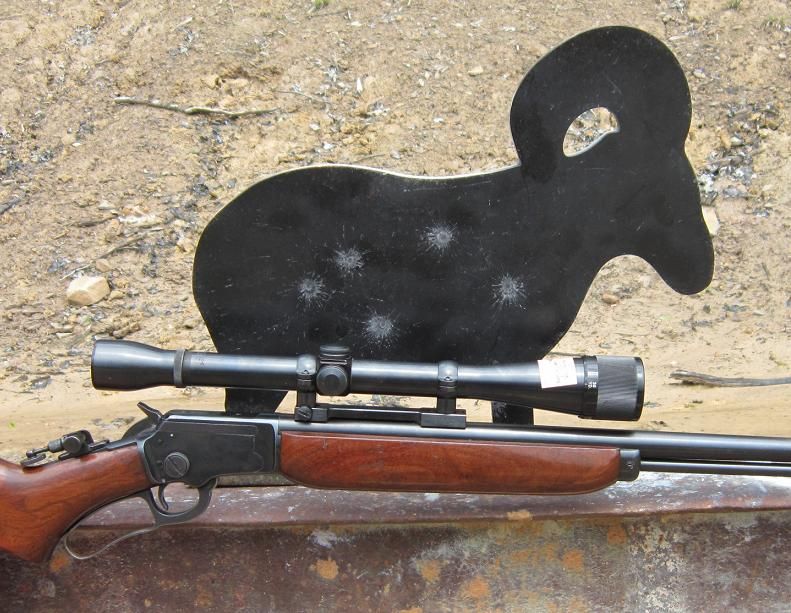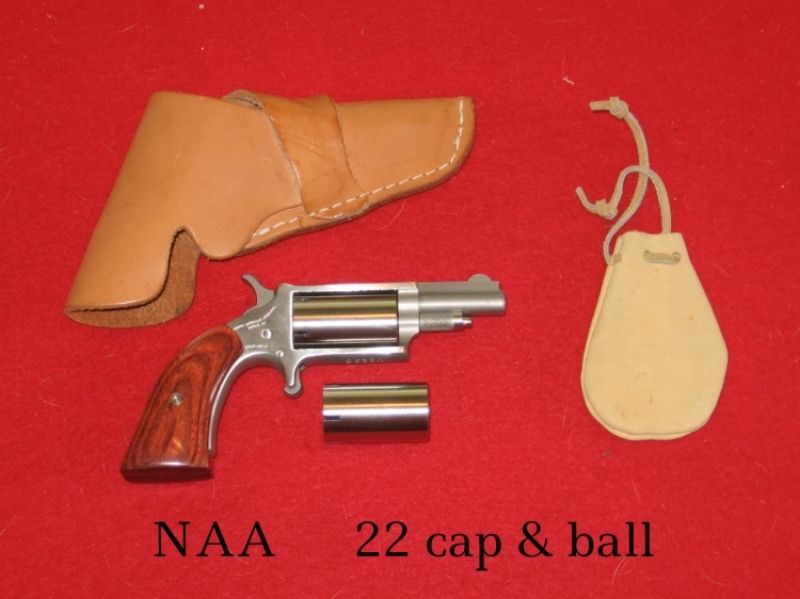I've always wanted to step back in time and test some original .22LR black powder cartridges to see how they would have performed back in the late 1800’s, early 1900’s in a levergun. Not too long ago I came across an old 2 piece box of early .22 LR cartridges. Most all the writing on the box was gone, but I could barely make out "UMC" on the bottom edge. I pulled one of the bullets and found that they were b.p. cartridges.
As the pic shows, the lube was dried out and there is some tarnishing of the copper case. Thankfully, they cleaned up ok. I used a toothbrush to clean off the dry lube and a bore brush to clean off the cartridge case. I then relubed with SPG.
![Image]()
The test rifle was a 39A Marlin made in 1948 equipped with a tang sight and an 8X vintage Weaver scope.
![Image]()
Well.......tried to fire a couple of the original UMC .22 b.p. cartridges, but click, click....priming compound is "deader than a doornail". I wasn't totally surprised, just a bit disappointed.
So......I spent a couple of hours cleaning and pulling bullets and powder from the UMC cartridges. Thankfully the case was not crimped into the bullet heel so the heel was not distorted in the process.
![Image]()
Bullet diameter .225" Weight: 40 grs.
factory powder compression: .035"
![Image]()
After loading the 4.5 grs. of the original powder into Armscor* cases, I seated the U.M.C. bullets with a Lyman H&I .225 die.
10 loaded and ready to go
![Image]()
I shot 10 of the assembled b.p. cartridges at my clubs’ 50 ft. indoor range since the weather wasn't too good outdoors at the time and I was anxious to test them.
They worked great ....just loaded 10 in the tube of my Marlin 39A (1948) and fired 2 groups of 5.
![Image]()
With the earlier success at 50 feet, I next wanted to try them at 50 yards which I was able to do a few weeks later. The Temp was 50F and it was a bit breezy (10-20 mph winds) but being a bit anxious, I decided to venture forth and shoot each shot when there was a lull in the wind.
Here are the two targets made with the 100+ year old component(s) that were loaded into Armscor* cases. I also tried 4.5 grs SWISS 4F with the UMC bullets which produced the group on the right. I was very pleased with the results. My reason for choosing SWISS is that it was the only b.p. that would not “foul out” in previous testing in the 32 Colt, 357, 44-40 and 45 Colt leverguns.
![Image]()
(Later testing with Swiss Null B which is finer than 4F went very well (100 yards target below).
Average velocity was 1,140 f.p.s.)
The next step was to find a suitable .22 mold to enable me to produce .22 LR black powder ammunition.
I had 3 different molds.....an early 225438 that weighed 42 grs., a new 225438 (45 grs) and a NEI 45 (45 grs.) in w.w. +2% tin alloy. In testing the old style 225438 proved to be the most accurate.
![Image]()
Ideally, the gas check shank should measure .209” or so for a snug fit into the .22 LR Armscor* case. The gc shank on that bullet measures .213” which then requires the case mouths to be flared prior to the bullet being seated. The loaded round is then run nose first into a 225” H&I die to restore the o.d. of the case back to its original dimension. I would use that mold in the short term, but a new mold would make things much easier and more consistant, so I made a drawing of the UMC bullet and sent it to David Mos to have a mold made to replicate it.
While waiting for the mold to arrive, I wanted to find out how many b.p. rounds the .22 Marlin could fire before accuracy might start to degrade using the 225438 lubed with SPG and propelled by 4.5 grs; of Swiss. So…after having shot 50 rounds of 3 different recipies (4.5 Swiss 4F, 4.5 Swiss Null B and 5.0 Swiss 4F) on Cowboy Silhouettes & other targets with no cleaning nor blow tubing, I fired rounds 51-58 (last of the cartridges) using 4.5/ Swiss Null B on this target to see if the fouling from the previous 50 rounds was having an affect on accuracy. Thankfully, it didn’t.
I was using the tang sight in this test since scopes are not permited in NRA Cowboy Silhouette. Accuracy was about as good as the 1948 vintage 39A with a tang sight will do with target .22 ammunition and my 67 year old eyes.
![Image]()
Now hopefully, that David Mos mold will arrive soon. I want to shoot b.p. in NRA Cowboy Small Bore Silhouette....just like those that have gone before us would have done if that competition was in existence 100+ years ago.
* Armscor .22 LR primed cases were available from THE HUNTING SHACK but I do not see them listed anymore. Previously, I removed bullets and powder from loaded .22 LR ammuniton to get cases
UPDATE.....
The KT22LR mold finally arrived and I made some bullets. The mold and bullet pics are courtesy of "Baja Traveler" who also ordered a mold.
![Image]()
![Image]()
I loaded them up over 4.5 gr of Swiss 4F and fired 10 rounds at 100 yards. I was very pleased with the results.
![Image]()
Now to load more for the upcoming NRA Cowboy Silhouette matches this year.:biggrin:
w30wcf
As the pic shows, the lube was dried out and there is some tarnishing of the copper case. Thankfully, they cleaned up ok. I used a toothbrush to clean off the dry lube and a bore brush to clean off the cartridge case. I then relubed with SPG.
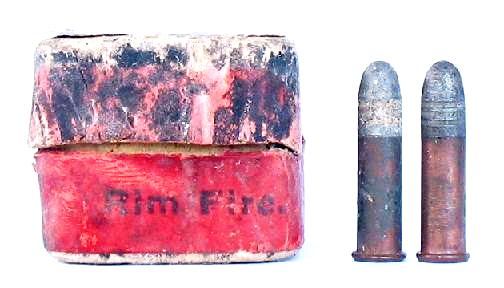
The test rifle was a 39A Marlin made in 1948 equipped with a tang sight and an 8X vintage Weaver scope.

Well.......tried to fire a couple of the original UMC .22 b.p. cartridges, but click, click....priming compound is "deader than a doornail". I wasn't totally surprised, just a bit disappointed.
So......I spent a couple of hours cleaning and pulling bullets and powder from the UMC cartridges. Thankfully the case was not crimped into the bullet heel so the heel was not distorted in the process.
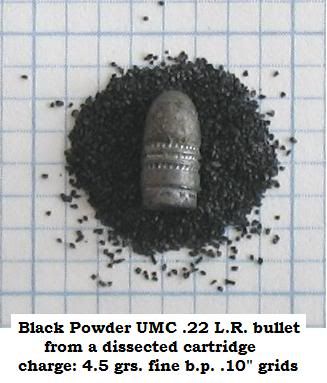
Bullet diameter .225" Weight: 40 grs.
factory powder compression: .035"
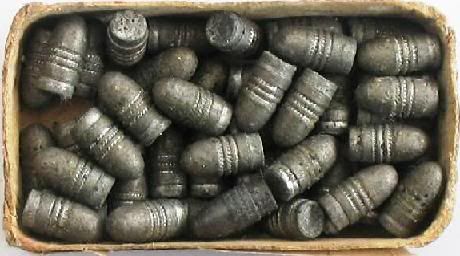
After loading the 4.5 grs. of the original powder into Armscor* cases, I seated the U.M.C. bullets with a Lyman H&I .225 die.
10 loaded and ready to go
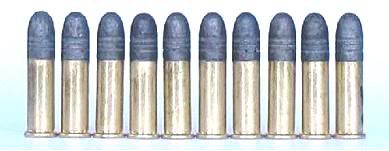
I shot 10 of the assembled b.p. cartridges at my clubs’ 50 ft. indoor range since the weather wasn't too good outdoors at the time and I was anxious to test them.
They worked great ....just loaded 10 in the tube of my Marlin 39A (1948) and fired 2 groups of 5.
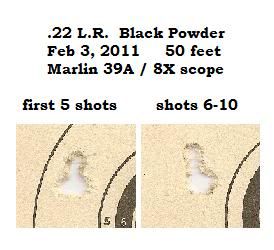
With the earlier success at 50 feet, I next wanted to try them at 50 yards which I was able to do a few weeks later. The Temp was 50F and it was a bit breezy (10-20 mph winds) but being a bit anxious, I decided to venture forth and shoot each shot when there was a lull in the wind.
Here are the two targets made with the 100+ year old component(s) that were loaded into Armscor* cases. I also tried 4.5 grs SWISS 4F with the UMC bullets which produced the group on the right. I was very pleased with the results. My reason for choosing SWISS is that it was the only b.p. that would not “foul out” in previous testing in the 32 Colt, 357, 44-40 and 45 Colt leverguns.
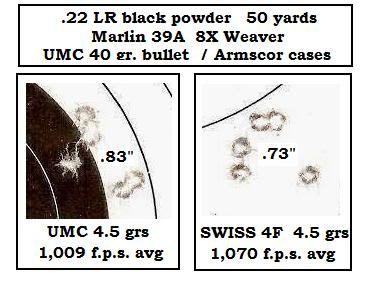
(Later testing with Swiss Null B which is finer than 4F went very well (100 yards target below).
Average velocity was 1,140 f.p.s.)
The next step was to find a suitable .22 mold to enable me to produce .22 LR black powder ammunition.
I had 3 different molds.....an early 225438 that weighed 42 grs., a new 225438 (45 grs) and a NEI 45 (45 grs.) in w.w. +2% tin alloy. In testing the old style 225438 proved to be the most accurate.
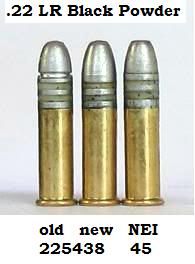
Ideally, the gas check shank should measure .209” or so for a snug fit into the .22 LR Armscor* case. The gc shank on that bullet measures .213” which then requires the case mouths to be flared prior to the bullet being seated. The loaded round is then run nose first into a 225” H&I die to restore the o.d. of the case back to its original dimension. I would use that mold in the short term, but a new mold would make things much easier and more consistant, so I made a drawing of the UMC bullet and sent it to David Mos to have a mold made to replicate it.
While waiting for the mold to arrive, I wanted to find out how many b.p. rounds the .22 Marlin could fire before accuracy might start to degrade using the 225438 lubed with SPG and propelled by 4.5 grs; of Swiss. So…after having shot 50 rounds of 3 different recipies (4.5 Swiss 4F, 4.5 Swiss Null B and 5.0 Swiss 4F) on Cowboy Silhouettes & other targets with no cleaning nor blow tubing, I fired rounds 51-58 (last of the cartridges) using 4.5/ Swiss Null B on this target to see if the fouling from the previous 50 rounds was having an affect on accuracy. Thankfully, it didn’t.
I was using the tang sight in this test since scopes are not permited in NRA Cowboy Silhouette. Accuracy was about as good as the 1948 vintage 39A with a tang sight will do with target .22 ammunition and my 67 year old eyes.
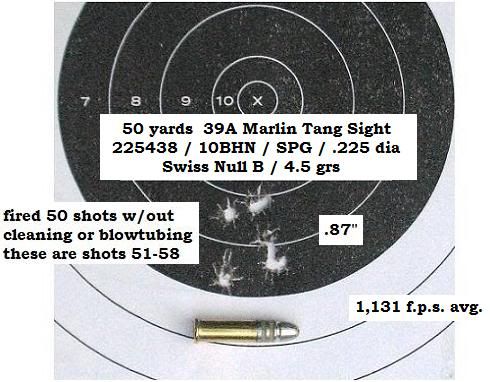
Now hopefully, that David Mos mold will arrive soon. I want to shoot b.p. in NRA Cowboy Small Bore Silhouette....just like those that have gone before us would have done if that competition was in existence 100+ years ago.
* Armscor .22 LR primed cases were available from THE HUNTING SHACK but I do not see them listed anymore. Previously, I removed bullets and powder from loaded .22 LR ammuniton to get cases
UPDATE.....
The KT22LR mold finally arrived and I made some bullets. The mold and bullet pics are courtesy of "Baja Traveler" who also ordered a mold.
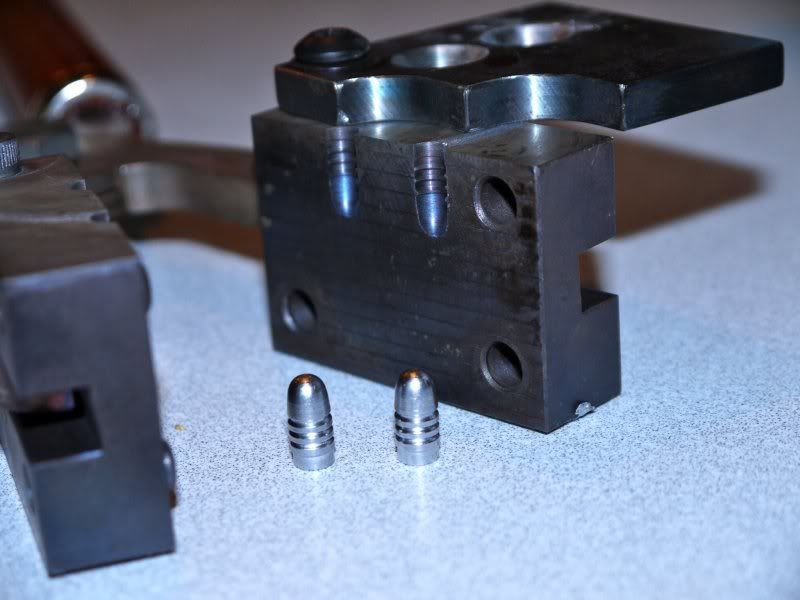
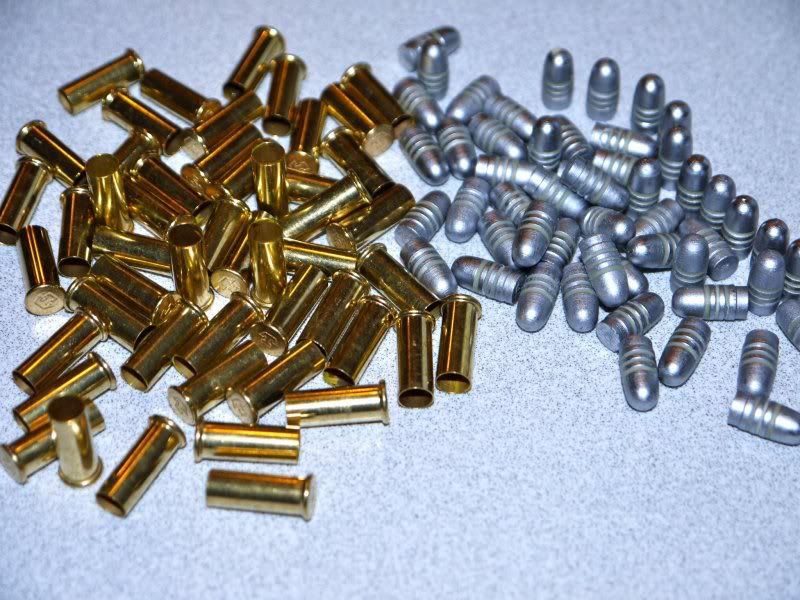
I loaded them up over 4.5 gr of Swiss 4F and fired 10 rounds at 100 yards. I was very pleased with the results.
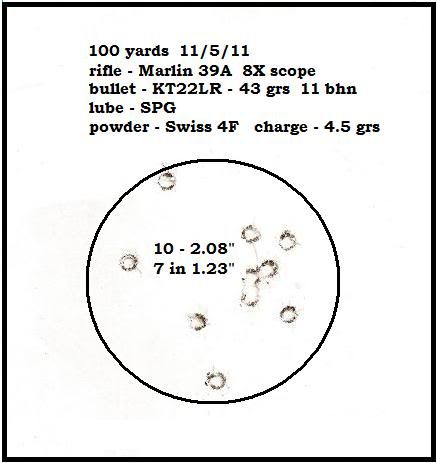
Now to load more for the upcoming NRA Cowboy Silhouette matches this year.:biggrin:
w30wcf


